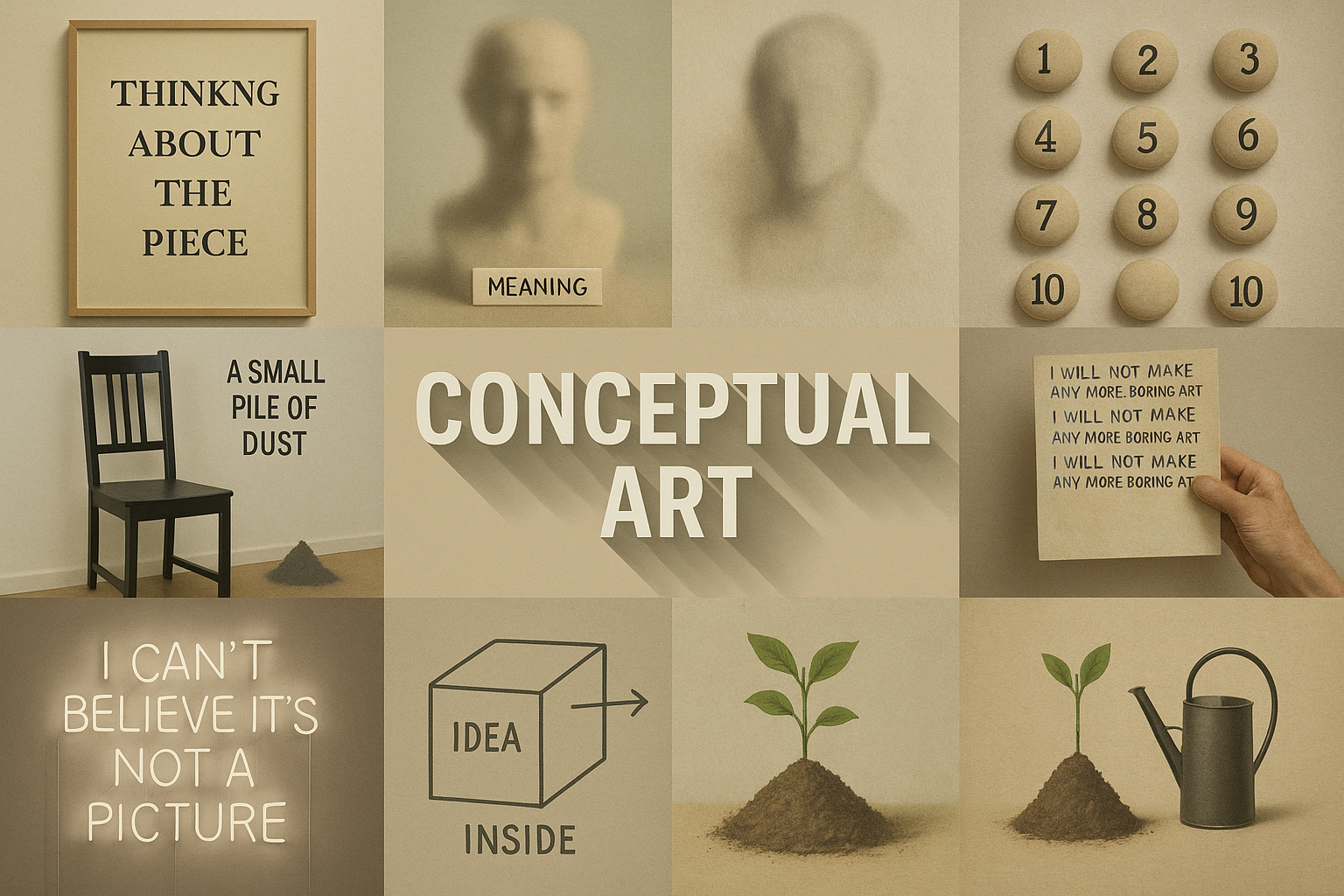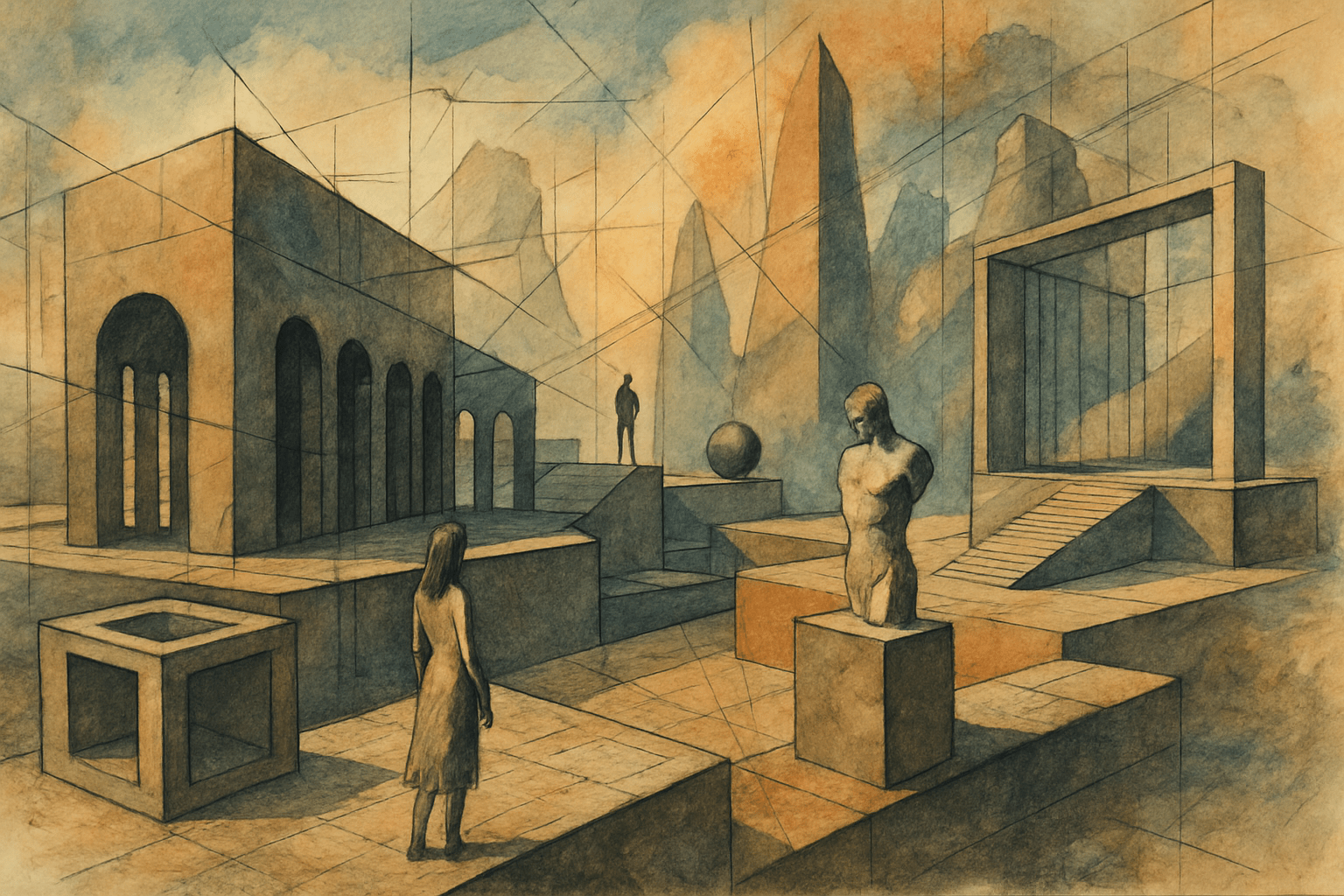
Conceptual art
There is no one answer to this question as conceptual art can take on many different visual appearances. Some common elements of conceptual art include the use of simple or everyday objects, the incorporation of text or words, and the use of non-traditional materials. The overall goal of conceptual art is to provoke thought or create a dialogue, so the visual appearance is often secondary to the concept or message being conveyed.
AOI thinking about Conceptual art [+_~]-/
Overview and Quickfacts
Conceptual art is an art movement that emphasizes ideas over traditional artistic techniques. Conceptual artists are often more concerned with the idea behind their work than the final product. This type of art often uses found objects and images to convey its message.
Can understand it also, as:
Abstract art, non-representational art, art without a subject
Categorize it as:
Impressionism, Modernism
.: Dreaming :.
holds a HAIKU for the art style
:. Thought is power .:
Detailed Description
Conceptual art is an art movement that emphasizes ideas over traditional artistic techniques. Many of the earliest examples of conceptual art were created in the 1960s by artists who were associated with the Dada movement, such as Marcel Duchamp and his famous “readymades” ÃÂÃÂ everyday objects that he declared to be art. In the late 1960s and early 1970s, artists like Joseph Kosuth and Lawrence Weiner began creating artworks consisting solely of text, which they called “conceptual” or “information” art. Famous conceptual artists include Yoko Ono, who is known for her instructions paintings, such as “Painting to Be Stepped On” and “Sky Piece”; and Sol LeWitt, who is known for his large-scale wall drawings. One of the most famous conceptual artworks is Duchamp’s “Fountain”, a urinal that he signed and submitted to an art exhibition in 1917. Conceptual art is often seen as a reaction against traditional art forms, such as painting and sculpture, which are seen as being too focused on the physical object. Instead, conceptual artists emphasize the idea or concept behind the work of art. As such, conceptual artworks are often quite minimal in appearance, and can take the form of anything from a written statement to a performance or an installation. While conceptual art is often associated with the avant-garde, it has also been embraced by the mainstream art world, with many major museums and galleries collecting and exhibiting works by conceptual artists.
.. beep, beep, beep ..
<START OF TRANSMISSION>
1. Conceptual art is an art movement that emphasizes ideas over traditional artistic techniques. 2. Conceptual artists are often more concerned with the idea behind a work than the work itself. 3. Many conceptual artists use found objects or ready-mades in their work. 4. Conceptual art often relies heavily on text and written documentation. 5. Conceptual art is sometimes seen as a reaction against traditional art forms. 6. The term "conceptual art" was first coined by the artist Henry Flynt in 1961. 7. The first major conceptual art exhibition was held in New York in 1967. 8. The most famous conceptual artist is probably Marcel Duchamp. 9. Duchamp's "Fountain" is often cited as the first work of conceptual art. 10. Other important early conceptual artists include Joseph Beuys and John Cage. 11. The British artist Damien Hirst is one of the most successful contemporary conceptual artists. 12. Hirst's "The Physical Impossibility of Death in the Mind of Someone Living" is one of the most famous conceptual artworks. 13. Conceptual art is often associated with the postmodernist movement. 14. Some critics have argued that conceptual art is a form of "intellectual masturbation." 15. Others have praised conceptual art for its ability to challenge traditional ideas about art. 16. Conceptual art is sometimes seen as a precursor to the digital art of the late 20th and early 21st centuries. 17. Conceptual art has also been influential in the development of performance art. 18. Many conceptual artists have used photography as a medium. 19. The American artist Sherrie Levine is best known for her re-photographs of works by other artists. 20. The German artist Hans Haacke is one of the most politically-engaged conceptual artists.
<EOF>
.. robbel bob
Visual Examples from our image gallery
Coming soon, we are so slow .. might never come
Artists, Paintings, and more
(be aware, can be highly speculative)
Artists (be aware, speculation possible):
1. Joseph Beuys (1921-1986) 2. John Cage (1912-1992) 3. Marcel Duchamp (1887-1968) 4. Richard Hamilton (1922-2011) 5. Jasper Johns (1930- ) 6. Yoko Ono (1933- ) 7. Robert Rauschenberg (1925-2008) 8. Cy Twombly (1928-2011) 9. Andy Warhol (1928-1987) 10. Lawrence Weiner (1942- ) 11. Eva Hesse (1936-1970) 12. Sol LeWitt (1928-2007) 13. Dan Flavin (1933-1996) 14. Donald Judd (1928-1994) 15. On Kawara (1933-2014) 16. Yves Klein (1928-1962) 17. Piero Manzoni (1933-1963) 18. Bruce Nauman (1941- ) 19. Robert Smithson (1938-1973) 20. Michael Asher (1943- ) 21. John Baldessari (1931- ) 22. Christian Boltanski (1944- ) 23. Hanne Darboven (1941-2009) 24. Gilbert & George (1943- ; 1942- ) 25. Richard Long (1945- ) 26. Bruce McLean (1944- ) 27. Paul McCarthy (1945- ) 28. Ed Ruscha (1937- ) 29. Cindy Sherman (1954- ) 30. Lorna Simpson (1960- )
Artworks (be aware, speculation possible)
1. “The Persistence of Memory” by Salvador Dali (1931) 2. “Nude Descending a Staircase, No. 2” by Marcel Duchamp (1912) 3. “Fountain” by Marcel Duchamp (1917) 4. ” readymades by Marcel Duchamp 5. “The Bride Stripped Bare by Her Bachelors, Even” by Marcel Duchamp (1915-23) 6. “I and the Village” by Marc Chagall (1911) 7. “The Red Studio” by Henri Matisse (1911) 8. “Portrait of Adele Bloch-Bauer I” by Gustav Klimt (1907) 9. “The Scream” by Edvard Munch (1895) 10. “The Starry Night” by Vincent van Gogh (1889) 11. “Nighthawks” by Edward Hopper (1942) 12. “One: Number 31, 1950” by Jackson Pollock (1950) 13. “Gray Painting” by Kazimir Malevich (1923) 14. “White on White” by Kazimir Malevich (1918) 15. “Black Square” by Kazimir Malevich (1915) 16. “Composition with Red, Yellow, and Blue” by Piet Mondrian (1921) 17. ” Broadway Boogie Woogie” by Piet Mondrian (1942-43) 18. “The Treachery of Images” by RenÃÂé Magritte (1928-29) 19. “This is Not a Pipe” by RenÃÂé Magritte (1928-29) 20. “The Son of Man” by RenÃÂé Magritte (1964) 21. “The Disintegration of the Persistence of Memory” by Salvador Dali (1954) 22. “The Persistence of Memory” by Salvador Dali (1931) 23. “The Persistence of Memory” by Salvador Dali (1931) 24. “The Persistence of Memory” by Salvador Dali (1931) 25. “The Persistence of Memory” by Salvador Dali (1931) 26. “The Persistence of Memory” by Salvador Dali (1931) 27. “The Persistence of Memory” by Salvador Dali (1931) 28. “The Persistence of Memory” by Salvador Dali (1931) 29. “The Persistence of Memory” by Salvador Dali (1931) 30. “The Persistence of Memory” by Salvador Dali (1931)
Epoch
The time period of the art style Conceptual art is the late 1960s through the present day.
AI ART RESSOURCES (AKA, well Tools)
Helping tools -> predefined search links on other pages:











